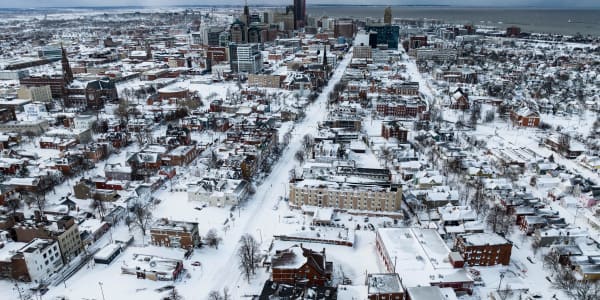America is at a crossroads. Not only are we about to elect a new president, but a dozen states will elect governors this year. The price of oil is still a fraction of its all-time high, dealing a body blow to the states that depend on it. For the others, the painfully slow recovery from the Great Recession is showing signs of stress just as they start to get their finances back on a solid footing.
That means the competition among states for business, jobs and the qualified workers to fill them is about to intensify, and this is where CNBC's annual America's Top States for Business comes in. Each year, using our tried-and-true methodology, we rank all 50 states across 10 categories that matter the most to business.
This year it's the 10th-annual Top States. We started studying the states at the peak of the real estate boom in 2007, when the U.S. economy seemed to be firing on all cylinders: 21 consecutive quarters of economic growth and a stock market that kept marching to new highs. Sure, there were rumblings about some frothiness in the housing market, but at the start of 2007, people were feeling pretty good. Business leaders were feeling good, too.
But there was something uneven about the expansion. Companies were growing and hiring in some states more than others. And because the economy had started to encounter a few headwinds, the competition to win a new plant or woo away an existing one began picking up. But there seemed to be little rhyme or reason about who would win.
Our idea was to try to understand why companies were making the decisions they did and to see whether those decisions matched up to the data. We also hoped to spark a national conversation about competitiveness. Top States has uniquely chronicled the ups and downs of the U.S. economy at the state level and the seismic shifts in the competitive landscape over the past 10 years. Our study shows which states truly put it all together and which ones don't.
Here are key lessons we have learned over the past decade about what it takes to become America's Top State for Business, and what it may take for 2016's Top State to put it all together this year.
1. Don’t put all your eggs in one basket — or one sector.
The economy of 2007 was tailor-made for Virginia, our inaugural Top State. The home of the Pentagon and all those defense contractors poised conveniently nearby, Virginia was bound to benefit from the steady growth in defense spending following 9/11 and the wars in Afghanistan and Iraq. A resurgent tech sector would not hurt either in a state that boasts of being the internet capital of the world. Plus, all those new workers would need housing, and the housing market was booming. But Virginia and the rest of the nation were about to get a rude awakening.
Less than a month after we unveiled our 2007 rankings, alarms were sounding.
By the time our 2008 rankings rolled around, states were staring down the barrel of a full-blown crisis. At its heart was housing — one of Virginia's strong suits. It was enough to dethrone the Old Dominion that year, because a different boom was beginning.
Our 2008 Top State, Texas, was revealed from the site of a drilling rig in the Barnett Shale near Fort Worth. Domestic oil and natural gas exploration were taking off. Not only had the War on Terror convinced Americans that energy independence is vital, but high prices and improved technology made domestic drilling more cost effective. Texas, a low-cost, business-friendly state to begin with, was ideally poised to capitalize.
2. Keeping costs down matters more when the economy stalls.
With the nation mired in the worst economic crisis since the Great Depression, newly elected President Obama and a Democratic-controlled Congress pushed through a nearly $800 billion stimulus plan, an increase in federal government spending bound to boost Virginia, which snatched the title back from Texas in 2009. But the winds were about to shift again.
The 2010 mid-term elections unleashed a Republican wave. Not only did the GOP win control of Congress, it swept state legislatures and governor races across the country. Low taxes became the centerpiece of economic development efforts in state after state, and because our study assigns weight to criteria based on how frequently states use them as selling points, the cost of doing business took on more importance than ever before.
With no personal or corporate income tax and an economy big and diverse enough to withstand the Great Recession, Texas came out on top again in 2010.
3. The true Top States never stop trying.
Texas has never slipped from the top tier, a fact then-Governor Rick Perry pointed out more than once during his first bid for the White House in 2012. He had already dropped out of the race by the time Texas won its third Top State title that year. Meantime, a few small cracks were appearing in the Texas juggernaut.
For one thing, the state was becoming a victim of its own success. Despite having no income tax, the cost of doing business in the Lone Star State was rising. Wages were going up because of the rapid expansion, and so were rents and property taxes.
Texans were also dealing with nagging quality of life issues that continue to this day. They include a lack of health insurance coverage, and limited protections against discrimination. Some Texans, Gov. Perry among them, cite both as positives — emblematic of the state's penchant for personal freedom. But many business leaders have raised concerns. Still, through 2015, Texas never finished lower than second place.
4. A worker shortage can keep a booming state from being a Top State.
The domestic energy push that we chronicled in Texas in 2008 began spreading like a prairie fire … into the actual prairie. North Dakota burst into our Top 5 in 2012 and climbed all the way up to third place in 2013. But in our study, an economy in hyperdrive is not enough to propel a state to the top. A severe worker shortage, schools that could not possibly keep up with the population surge, and a shortage of technology and innovation have all held the state back.
But North Dakota's fortunes did have a halo effect on its neighbor to the south, making South Dakota the dark horse winner in 2013. South Dakota is not an oil state, but the explosive growth to the north certainly rubbed off. Yet South Dakotans enjoyed low costs and friendly regulation (not to mention some amazing scenery). The state suffered from its own worker shortage, though, and that was about to become a big problem when it came to competitiveness.
5. More than ever, a great workforce matters.
Experts call it the Skills Gap. With a recovering economy, companies have jobs to fill. And with the Great Recession just barely over, millions of workers remain unemployed. Yet companies complain they can't find qualified people. So the jobs go unfilled, and workers remain jobless.
As the recovery took hold in 2014, a new battleground among the states was emerging: the battle for the best workforce. Companies increasingly were choosing locations not just based on the cost structure but on the availability of skilled employees. The rise of the worker meant the South would rise again that year. Georgia, to be specific.
A big state with a thorough infrastructure and reasonably low costs, Georgia has typically done well in our study. But a severely overbuilt housing market hurt the state badly in the recession. The state lagged the nation in job growth, leading to a surplus of workers at a time when workers were in high demand.
By 2015, states were actively touting their workforces to the point that for the first time, Workforce surpassed Cost of Doing Business in terms of weight in our study. It was enough to tip the balance in favor of Minnesota. It is a high-cost, high-union state, but also a high-value state, insisted Gov. Mark Dayton after we crowned his state Tops last year.
What it will take to be 2016's Top State for Business
This year the skills gap is no less severe. But other issues are rising to the surface. The domestic-energy boom that was in its infancy when we began our study a decade ago is in serious trouble as oil prices collapse. It is a rude awakening in the states that have been riding that boom all these years.
At the same time, the economic recovery that has allowed some states to rebuild their finances — and their economic development war chests — is showing its own signs of stress. States are dealing with crumbling infrastructure, mounting pension debt and social cross-currents that are disrupting longstanding alliances between companies and the states where they operate.
The new challenges promise to shake up the rankings again, but Top States will be here to try and bring order to the chaos. We know that regardless of rankings, every state has unique advantages, just as every business has unique needs. So we like to think of America's Top States for Business as a way to start important conversations about what it takes to compete.
It's CNBC's 10th annual America's Top States for Business study — the most comprehensive and authoritative look at state competitiveness around — and it's coming soon!
As always, we want to know what you think. Share your comments here, or on Twitter using the hashtag #TopStates.






